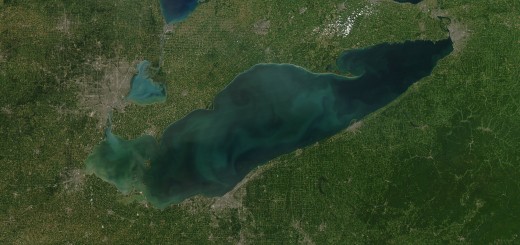Killer Shrimp Set Sights On Great Lakes
0For now, killer shrimp remain a menace to Western Europe’s waters, but experts at McGill University say the invasive shrimp may be coming to the Great Lakes in the near future. If no new regulations are put in place to stem the incoming flow of invasives, killer shrimp and other harmful invasive species will make the Great Lakes their home within the next 50 years, according to a release from the school.
Researchers urge better rules to help stem the tide of invasives they predict. The killer shrimp could be particularly damaging to the Great Lakes because of their ruthless nature: They prey on invertebrates, young fish and other invasive species indiscriminately. Sometimes they kills their prey for sport and don’t even eat them.

Great Lakes region as seen from space. (Credit: NASA)
Researchers at McGill make the estimate in a study looking at more than 180 non-native species that have become established within the Great Lakes basin in the past two centuries. These include the likes of the Eurasian Ruffe, Round Goby and Zebra Mussel. The incursions of these and other invasive species were linked to ballast water discharges from ships after the St. Lawrence Seaway was opened in 1959, researchers say.
They write in the Journal of Great Lakes Research, “…recent regulations have apparently reduced the threat of this vector. Nevertheless, non-native species may continue to be introduced through poorly regulated vectors, particularly those associated with trade in live organisms.”

Killer Shrimp. (Credit: McGill University)
Climate change is also adding concerns for controlling the spread of these species, scientists say. Warmer waters are the biggest threat because they may make the basin more hospitable to species who otherwise wouldn’t be able to live there. The migration and establishment of southern species via the canal from the Mississippi River to the Great Lakes is likely, they say. Warmer temperatures could also help diseased organisms complete life cycles faster, while spurring the rise of non-native fish in the Great Lakes, like Rainbow Smelt and Sea Lamprey.
Researchers ran three scenarios in their investigation. One assumed the worst-case scenario of ineffective regulations leading to a flood of new invasive species in the Great Lakes. Another looked at what might happen if no new regulation measures were introduced by either the U.S. or Canada.
The best scenario for deterring the threat of invasives, scientists found, is for the United States and Canadian governments to work together to improve regulations and reduce invasive-species risks.
“In addition to harmonized regulations on live trade, the two countries must coordinate early detection and rapid response to new threats – before an invasion has progressed beyond control,” said Anthony Ricciardi, professor of biology and invasive species expert at McGill, in a statement.












